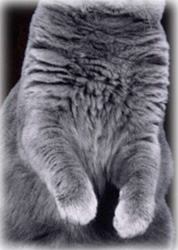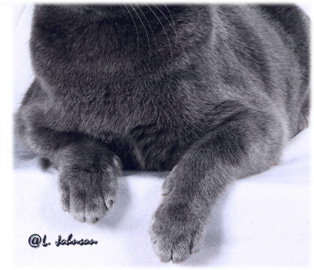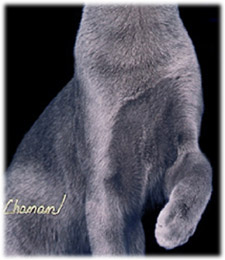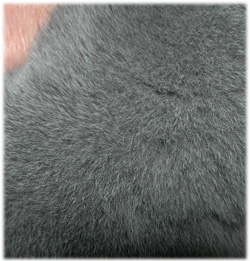| British Shorthair
COAT:The coat is short,
very dense, well bodied, and firm to the touch. Not double coated
or woolly.COLOR: for cats with special markings: 5 points for coat
color and 10 points for markings. Shadow tabby markings in solid
color, smoke, shaded, shaded golden, bi-color, or calico kittens
are not a fault.
COLOR:
Solid - White; black; blue; red; cream; smoke; shaded silver; shaded
golden; chinchilla silver; chinchilla golden; shell cameo; shaded
cameo.
Tabby colors and patterns - classic tabby; mackerel tabby; spotted
tabby; silver, sliver patched, and sliver patched tabby and white
(all patterns); red tabby (all patterns); brown, brown patched,
brown patched tabby and white (all patterns); blue, blue patched,
and blue patched tabby and white (all patterns); cream tabby (all
patterns) tabby and white (all patterns); van tabby and white (all
patterns
Bi-colors and Parti-colors - tortiseshell, calico and dilute calico,
van and van dilute calico, blue-cream, bi-color, van bi-color.
DISQUALIFY: Long or fluffy coat.Evidence of hybridization
resulting in the colors chocolate, lavender, the himalayan pattern,
or these combinations with white. (individual colors may have additional
disqualifications - these apply to all examples of the breed)
|
Chartreux
COAT: Medium-short and
slightly woolly in texture (should break like a sheepskin at neck
and flanks). Resilient undercoat; longer, protective topcoat. NOTE:
degree of woolliness depends on age, sex and habitat, mature males
exhibiting the heaviest coats. Silkier, thinner coat permitted on
females and cats under two years.
COLOR: any shade of blue-gray from ash to slate; tips lightly
brushed with silver. Emphasis on color clarity and uniformity rather
than shade. Preferred tone is a bright, unblemished blue with an
overall iridescent sheen. Nose leather is slate gray; lips blue;
paw pads are rose-taupe. Allowance made for ghost barring in kittens
and for tail rings in juveniles under two years of age.
DISQUALIFY: white locket |
Korat
COAT: single. Hair is short in length, glossy
and fine, lying close to the body. The coat over the spine is inclined
to break as the cat moves.
COLOR: silver-tipped blue all over, the silver should be
sufficient to produce a silver halo effect. The hair is usually
lighter at the roots with a gradient of blue which is deepest just
before the tips which are silver. Adults should be without shading
or tabby markings. Allow for ghost tabby markings in kittens. Where
the coat is short, the sheen of the silver is intensified. Undesirable:
coats with silver tipping on only the head, legs and feet. Nose
leather and lips: dark blue or lavender. Paw pads: dark blue ranging
to lavender with a pinkish tinge.
DISQUALIFY: White spot or locket. Any color
but silver-tipped blue.
|
Russian Blue
COAT: short, dense, fine, and plush.
Double coat stands out from body due to density. It has a distinct
soft and silky feel.
COLOR: even bright blue throughout. Lighter shades of blue
preferred. Guard hairs distinctly silver-tipped giving the cat a
silvery sheen or lustrous appearance. A definite contrast should
be noted between ground color and tipping. Free from tabby markings.
Nose leather: slate grey. Paw pads: lavender pink or mauve.
DISQUALIFY: Locket or button. Incorrect number
of toes. Any color other than blue. Long coat. |











